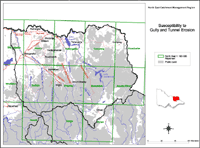Susceptibility to Gully and Tunnel Erosion
 Susceptibility to Gully & Tunnel Erosion | The susceptibility of land to tunnelling and gully erosion depends on a number of interrelated factors. These are principally rainfall intensity, vegetation cover, rooting depth, microrelief, slope, position in landscape, contributing upslope area, soil permeability, soil depth, soil cohesion and dispersibility. As the volume of overland flow increases and becomes channelised, the erosive power increases and resistance of the soil aggregates and particles to detachment becomes critical. The size and weight of the soil particles and their cohesion, or the tendency to slake or disperse will determine the resistance. Gully erosion occurs particularly in areas on Ordovician sediments, but is also common on granitic and glacial parent material. When gradational soils and stony loams on crests and upper slopes are cleared of the native deep-rooted vegetation, some rain percolates through the soil profile to the watertable, but some becomes overland flow with the potential to sheet erode the sloping land and scour out drainage depressions. |
Broad overview susceptibility mapping across the North East region. To view the information PDF requires the use of a PDF reader. This can be installed for free from the Adobe website (external link).
(PDF 579KB)
The land characteristics and management factors involved in gully and tunnel erosion are described in Table 6.
Table 6 Land characteristics and management factors involved in gully and tunnel erosion
| Processes | Land features affecting processes | Factors affected by land characteristics | Management factors that modify land characteristics |
| Gully and tunnel erosion occur when the forces due to rainfall, flowing water and gravity overcome the cohesion and weight of the soil particles/aggregates | Vegetation
|
| All aspects of the vegetation are affected by selection of species and control of biomass by practices such as cultivating clearing trafficking fertilising grazing trampling harvesting burning |
Processes involved are:
- channelised overland flow - cracking | Climate
|
| |
| Geology
|
| |
- subsurface flow - gravity collapse deposition | Topography
|
| Contour and diversion banking, strip cropping and contour cultivating reduce catchment slope length and catchment area; they also affect microrelief Contour and diversion banking, strip cropping and contour cultivating reduce catchment slope length and catchment area; they also affect microrelief |
| Gully erosion is regarded as having occurred when the channel is too deep to be crossed or cannot be obliterated by tillage Off-site effects include increased sedimentation and runon in streams and on lower lands | Soil
|
| Type and amount of biomass production will affect soil organic matter content, which will in turn affect most listed soil characteristics Soil disruption and compaction by trampling, burrowing, cultivating and trafficking will affect profile permeability, water-holding capacity and size/weight and cohesion of soil particles/aggregates |


